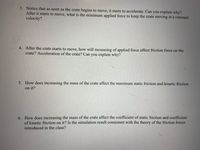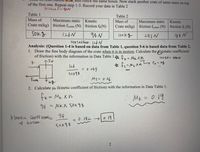
College Physics
11th Edition
ISBN: 9781305952300
Author: Raymond A. Serway, Chris Vuille
Publisher: Cengage Learning
expand_more
expand_more
format_list_bulleted
Concept explainers
Topic Video
Question
3. Notice that as soon as the crate begins to move, it starts to accelerate. Can you explain why?
After it starts to move, what is the minimum applied force to keep the crate moving at a constant
velocity?
4. After the crate starts to move, how will increasing of applied force affect friction force on the
crate? Acceleration of the crate? Can you explain why?
5. How does increasing the mass of the crate affect the maximum static friction and kinetic friction
on it?
6. How does increasing the mass of the crate affect the coefficient of static friction and coefficient
of kinetic friction on it? Is the simulation result consistent with the theory of the friction forces
introduced in the class?

Transcribed Image Text:3. Notice that as soon as the crate begins to move, it starts to accelerate. Can you explain why?
After it starts to move, what is the minimum applied force to keep the crate moving at a constant
velocity?
4. After the crate starts to move, how will increasing of applied force affect friction force on the
crate? Acceleration of the crate? Can you explain why?
5. How does increasing the mass of the crate affect the maximum static friction and kinetic friction
on it?
6. How does increasing the mass of the crate affect the coefficient of static friction and coefficient
of kinetic friction on it? Is the simulation result consistent with the theory of the friction forces
introduced in the class?

Transcribed Image Text:aIS8 check the same boxes. Now stack another crate of same mass on top
of the first one. Repeat step 1-3. Record your data in Table 2
friction f-9AN
Table 1
Table 2
Mass of
Maximum static
Kinetic
Mass of
Maximum static
Kinetic
Crate m(kg) friction fs.max (N) friction fr(N)
Crate m(kg) friction fs.max (N) friction fg (N)
50kg
126N
94N
lookg
251N
188N
app ried force: 126N
Analysis: (Question 1-4 is based on data from Table 1, question 5-6 is based data from Table 2.
1. Draw the free body diagram of the crate when it is in motion. Calculate the (static coefficient
of friction) with the information in Data Table 1 fre Mk Xn
30A9.8= 490 N
FN
126
☆ fs= Ms ans Fx= mg
= 0.257
max
50X9.8
fimax
Ms= 0 26
mg
2. Calculate µk (kinetic coefficient of friction) with the information in Data Table 1:
fx= Mk X n
Mk = 0-19
94 = MKX 50x 98
%3D
KTnetic Coelficent 94
= 0.192 o. 19
of forction.
50x9.8
2
Expert Solution
This question has been solved!
Explore an expertly crafted, step-by-step solution for a thorough understanding of key concepts.
This is a popular solution
Trending nowThis is a popular solution!
Step by stepSolved in 2 steps

Knowledge Booster
Learn more about
Need a deep-dive on the concept behind this application? Look no further. Learn more about this topic, physics and related others by exploring similar questions and additional content below.Similar questions
- 1.arrow_forwardExplain Newton's second Law and solve related problems Given a block which is at rest on a perfectly flat smooth table. You push with your hand horizontally on the block with some force. If the mass of the block = 2.00 kg and the acceleration of the block = 5.00 m/s2 then what is the force on the block from your hand in SI units? a. 2.50 N b. 0.100 N c. 0.400 N d. 10.0 N e. zeroarrow_forwardYou push a lawnmower (mass=15kg) across the lawn at constant speed. To do so, you must excert 200 N of force. The handle makes a 35° angle with the horizontal. A. Draw the force diagram B. What is the x-component of the force you apply? C. How does it compare to the frictional force which opposes your effort? Explain. D. If the frictional force is reduced to 100 N, determine the acceleration of the lawnmower.arrow_forward
- 2. A 10. Kg box pulled with a 40. N force at an angle of 20. degrees above the horizontal. The coefficient of kinetic friction is 0.20. Note it is moving along the table top. a) Draw a FBD showing all forces and the components of the pulling force. b) Determine the normal force. c) Determine force of friction acting on the box. d) Determine the acceleration of the box. e) Assume the box started from rest and was pulled for 2.0 seconds. Then the pulling force was removed. (i) Find the speed of the box after the 2.0 seconds. (ii) Determine how long it took for the box to come to rest after the pulling force was removed. 10kg -> 40N <200arrow_forwardA 10-kg wooden box rests on a ramp that is lying flat. The coefficient of static friction is 0.50, and the coefficient of kinetic friction is 0.30. What is the friction force between the box and ramp if a 30 N horizontal force is applied to the box? A.50 N B.20 N C.0 N D.30 Narrow_forwardTwo objects accelerate at 1 m/s2. How do the applied forces compare? A. They are different B. They are the same C. I can't tell without the mass For a given object, which force due to friction is typically larger? A. They are different B. Kinetic friction C. Static friction D. Now way to tell without knowing the massarrow_forward
- F-H Only! Pleasearrow_forwardA restaurant manager pushes a box of melons horizontally with a force of magnitude 150 N. The box moves along the floor with a constant acceleration in the same direction as the applied force. Which statement is more precise regarding the magnitude of the kinetic friction force acting on the crate? a. It is greater than 150 N. b. It is equal to 150 N. c. The friction force must be zero. d. The kinetic friction force is constantly decreasing. e. It is less than 150N.arrow_forwardA person pushes a box with a small constant force to move the box along the floor at a constant speed in a straight-line path. Which of the following statements is true? a. The net force on the box is zero. b. There are no other forces on the box (besides the person’s push.) c. The net force on the box must be greater than zero to keep the box moving. d. The box has an acceleration that is not zero. e. [Both (c) and (d) are true.]arrow_forward
- A 75 kg parent and a 22 kg child meet at the center of an ice rink. They place their hands together and push hard enough to slide apart. a. Is the force experienced by the child more than, less than, or the same force experienced by the parent? b. Is the acceleration of the child more than, less than, or the same acceleration as the parent? c. If the acceleration of the child is 2.3 m/s2 in magnitude, what is the magnitude of the force of the parent's push on the child?arrow_forward3. Two blocks A and B are connected by a rope and pulled with some force F along a frictionless horizontal surface, as shown. B a. Draw a free-body diagram for each block. b. Write Newton's second law for each block and obtain equations for the x and y directions. c. If the tension in the rope is given by T = F/3, find the ratio of the masses, ma/mg.arrow_forwardResearchers often use force plates to measure the forces that people exert against the floor during movement. A force plate works like a bathroom scale, but it keeps a record of how the reading changes with time. Shown is the data from a force plate as a woman jumps straight up and then lands.a. What was the vertical component of her acceleration during push-off?b. What was the vertical component of her acceleration while in the air?c. What was the vertical component of her acceleration during the landing?d. What was her speed as her feet left the force plate?e. How high did she jump?arrow_forward
arrow_back_ios
SEE MORE QUESTIONS
arrow_forward_ios
Recommended textbooks for you
 College PhysicsPhysicsISBN:9781305952300Author:Raymond A. Serway, Chris VuillePublisher:Cengage Learning
College PhysicsPhysicsISBN:9781305952300Author:Raymond A. Serway, Chris VuillePublisher:Cengage Learning University Physics (14th Edition)PhysicsISBN:9780133969290Author:Hugh D. Young, Roger A. FreedmanPublisher:PEARSON
University Physics (14th Edition)PhysicsISBN:9780133969290Author:Hugh D. Young, Roger A. FreedmanPublisher:PEARSON Introduction To Quantum MechanicsPhysicsISBN:9781107189638Author:Griffiths, David J., Schroeter, Darrell F.Publisher:Cambridge University Press
Introduction To Quantum MechanicsPhysicsISBN:9781107189638Author:Griffiths, David J., Schroeter, Darrell F.Publisher:Cambridge University Press Physics for Scientists and EngineersPhysicsISBN:9781337553278Author:Raymond A. Serway, John W. JewettPublisher:Cengage Learning
Physics for Scientists and EngineersPhysicsISBN:9781337553278Author:Raymond A. Serway, John W. JewettPublisher:Cengage Learning Lecture- Tutorials for Introductory AstronomyPhysicsISBN:9780321820464Author:Edward E. Prather, Tim P. Slater, Jeff P. Adams, Gina BrissendenPublisher:Addison-Wesley
Lecture- Tutorials for Introductory AstronomyPhysicsISBN:9780321820464Author:Edward E. Prather, Tim P. Slater, Jeff P. Adams, Gina BrissendenPublisher:Addison-Wesley College Physics: A Strategic Approach (4th Editio...PhysicsISBN:9780134609034Author:Randall D. Knight (Professor Emeritus), Brian Jones, Stuart FieldPublisher:PEARSON
College Physics: A Strategic Approach (4th Editio...PhysicsISBN:9780134609034Author:Randall D. Knight (Professor Emeritus), Brian Jones, Stuart FieldPublisher:PEARSON

College Physics
Physics
ISBN:9781305952300
Author:Raymond A. Serway, Chris Vuille
Publisher:Cengage Learning

University Physics (14th Edition)
Physics
ISBN:9780133969290
Author:Hugh D. Young, Roger A. Freedman
Publisher:PEARSON

Introduction To Quantum Mechanics
Physics
ISBN:9781107189638
Author:Griffiths, David J., Schroeter, Darrell F.
Publisher:Cambridge University Press

Physics for Scientists and Engineers
Physics
ISBN:9781337553278
Author:Raymond A. Serway, John W. Jewett
Publisher:Cengage Learning

Lecture- Tutorials for Introductory Astronomy
Physics
ISBN:9780321820464
Author:Edward E. Prather, Tim P. Slater, Jeff P. Adams, Gina Brissenden
Publisher:Addison-Wesley

College Physics: A Strategic Approach (4th Editio...
Physics
ISBN:9780134609034
Author:Randall D. Knight (Professor Emeritus), Brian Jones, Stuart Field
Publisher:PEARSON